Titolo |
| Curare sul Web: L’evoluzione delle piattaforme come spazi di produzione e diffusione dell’arte sul web |
Autore |
| Marialaura Ghidini |
Anno |
| 2019 |
CASA EDITRICE |
| Arts Journal |
Descrizione |
| Attraverso l'analisi di una serie di progetti espositivi che rispondono ai cambiamenti centrali della tecnologia web dalla sua inaugurazione pubblica (1991), questo studio identifica una traiettoria storica per discutere l'evoluzione della curatela sul web. Tale evoluzione evidenzia come i curatori abbiano ideato modelli espositivi che operano come piattaforme non solo per esporre l'arte specificatamente sul web, ma anche per produrla e diffonderla in un modo che risponda agli sviluppi della tecnologia web e al suo impatto socio-culturale ed economico. Con la massificazione degli strumenti web, infatti, queste piattaforme hanno generato sistemi distribuiti di produzione artistica liberi dalle limitazioni fisiche e concettuali dello spazio della galleria e del museo. Non sono diventati solo spazi per esporre l'arte, ma anche piattaforme che ne alimentano la produzione, diverse modalità di coinvolgimento del pubblico e criticano i canoni del mondo dell'arte istituzionalizzato. |
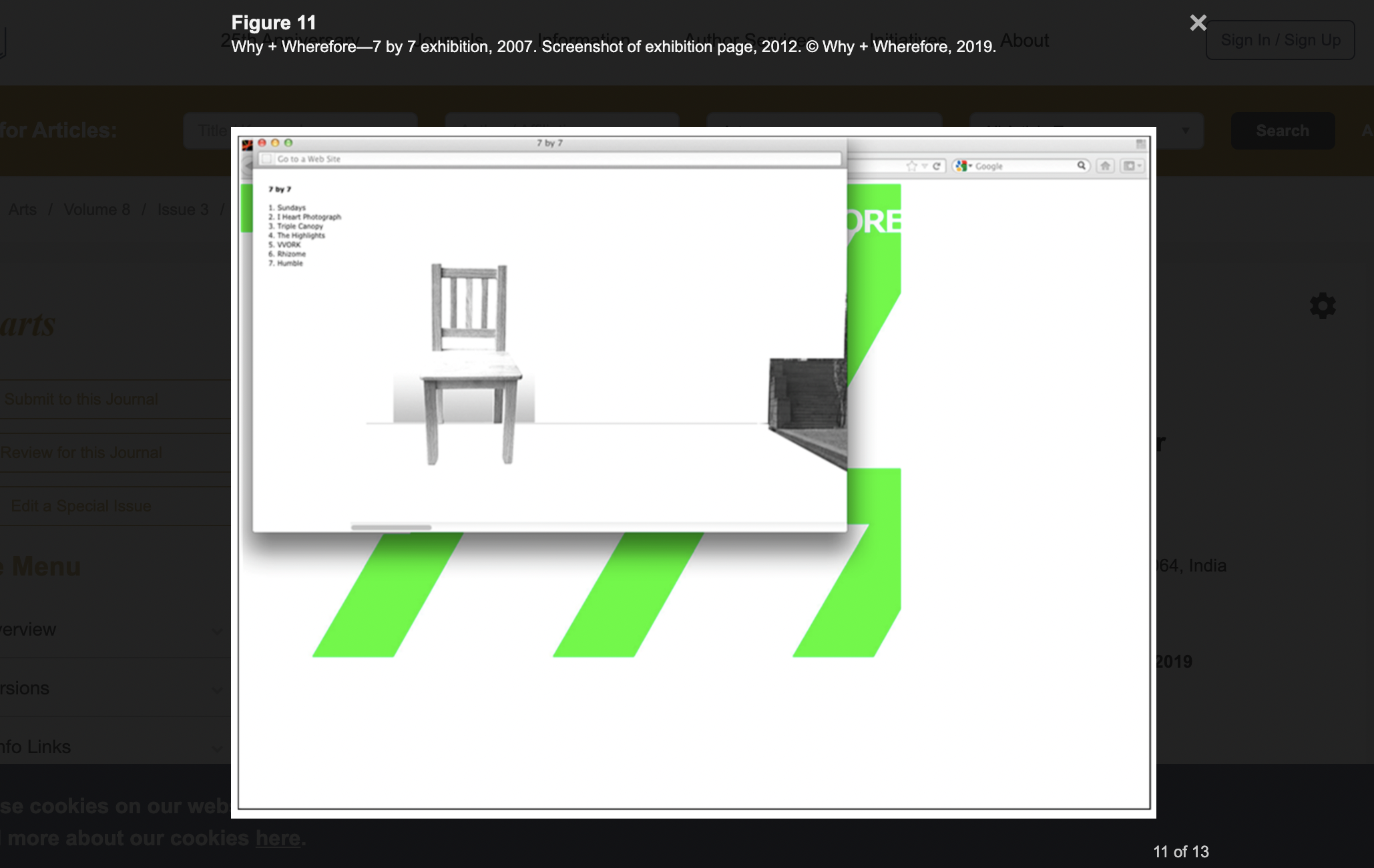 |
url |
| https://www.mdpi.com/2076-0752/8/3/78/htm |
Titolo |
| Curatela di mostre online – Parte 1: Performance, variabilità, oggettualità |
Autore |
| Michael Connor |
Anno |
| 2020 |
CASA EDITRICE |
| Rhizome |
Descrizione |
| Con le mostre fisiche in tutto il mondo ormai chiuse a causa della pandemia COVID-19, le istituzioni e gli artisti stanno affrontando con improvvisa urgenza le questioni relative al creare mostre online. Il compito potrebbe sembrare relativamente semplice a prima vista: fornire un punto di accesso per il grande pubblico a programmi e informazioni che sarebbero altrimenti fruibili di persona. [...] |
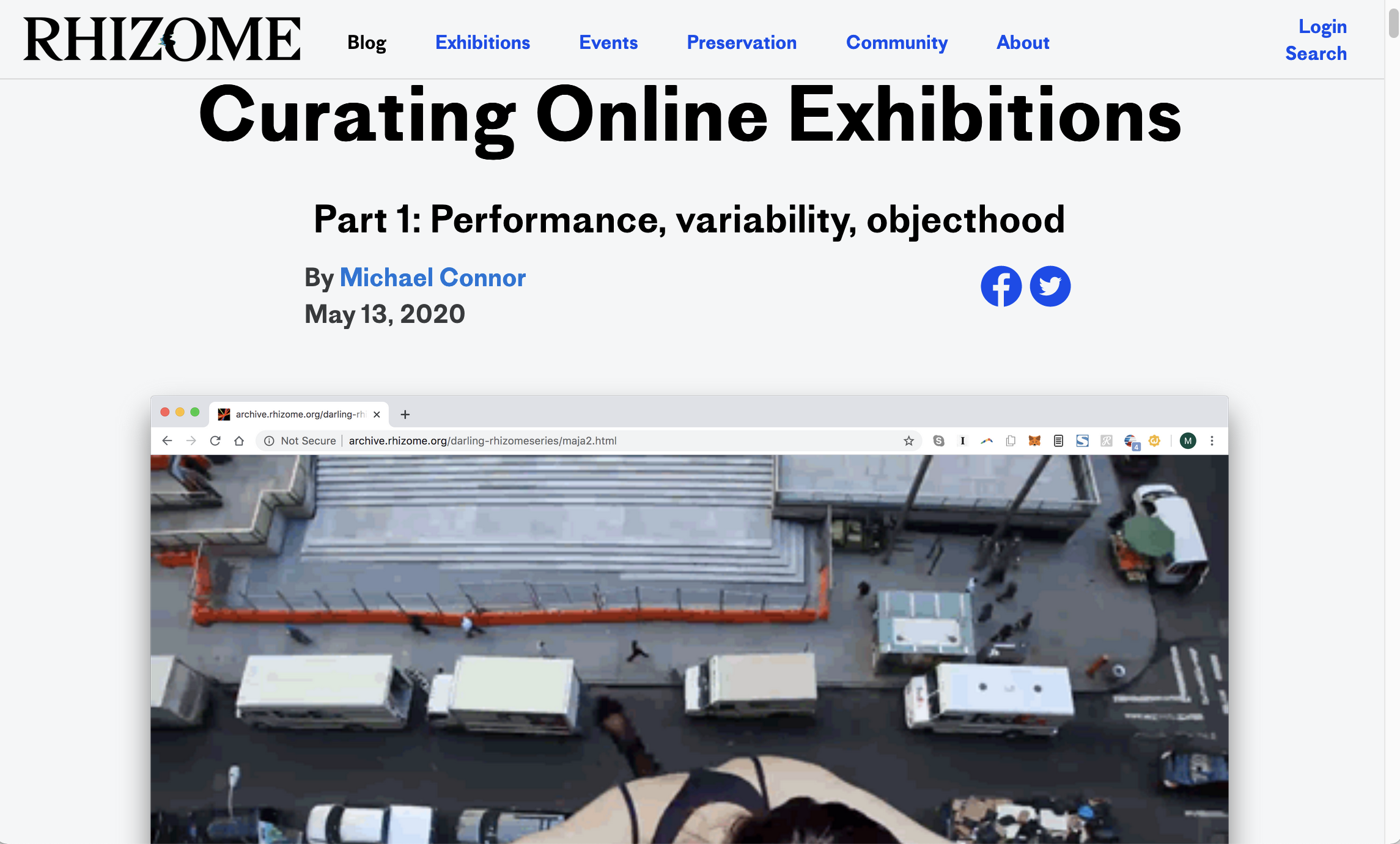 |
url |
| https://rhizome.org/editorial/2020/may/13/curating-online-exhibitions-pt-1/ |
Titolo |
| Curare l’Immagine in Rete: Circolazione, Commodificazione, Computazione |
Autore |
| Gaia Tedone |
Anno |
| 2019 |
CASA EDITRICE |
| The Centre for the Study of the Networked Image, London South Bank University, Regno Unito |
Descrizione |
| Nel contesto attuale della cultura in rete, dove le opere d'arte e le fotografie circolano online insieme ad altre merci e oggetti digitali, gli utenti online così come gli strumenti di aggregazione dei dati partecipano alla selezione, filtraggio e diffusione dei contenuti visivi. Il conflitto di differenziazione che emerge all'interno dello spazio condiviso di Internet è allo stesso tempo estetico, sociale e politico. Al centro di questa ricerca c'è la questione di come la curatela delle immagini in rete possa produrre valore culturale e significato sociale di fronte a una tale commistione di interessi e intenzioni. Questo studio afferma la necessità di riconsiderare il paradigma convenzionale della curatela d'arte alla luce di queste condizioni mutevoli e in risposta alla disciplina emergente della curatela digitale, e riposiziona il ruolo del curatore e il lavoro delle immagini in rete in questo campo accelerato e in evoluzione. |
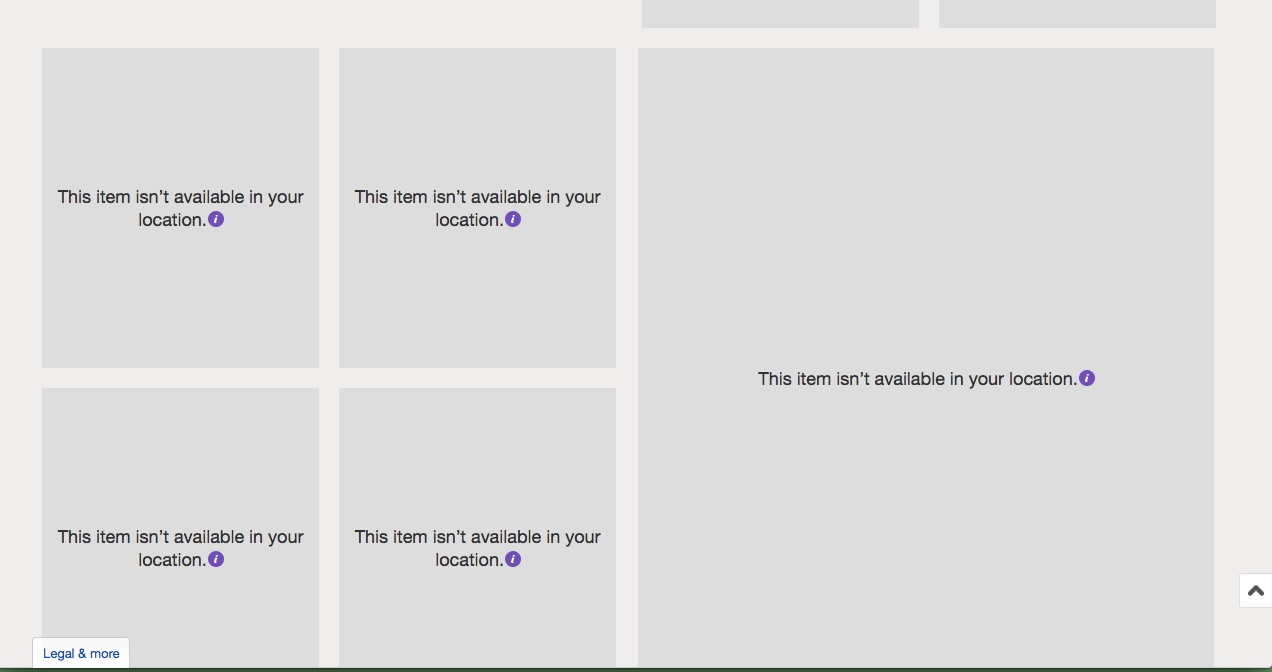 |
Titolo |
| Curare Mostre d’Arte sul Web: Mappando Formati Espositivi Online e Offline |
Autore |
| Marialaura Ghidini |
Anno |
| 2015 |
CASA EDITRICE |
| University of Sunderland |
Descrizione |
| Questa tesi indaga la teoria e la prassi della curatela di mostre sul web dalla prospettiva di una persona che la pratica (l'autrice Marialaura Ghidini). In particolare, indaga il modo in cui il web come mezzo di produzione, esposizione, distribuzione e critica abbia avuto un impatto sul lavoro e sulla ricerca dei curatori indipendenti e sul modo in cui configurano i loro progetti espositivi. Con un particolare accento sull'ultimo decennio, il lavoro curatoriale di produzione e commissione è considerato in relazione agli sviluppi tecnologici, al precedente lavoro teorico di mappatura delle mostre online e all'analisi di casi di studio che sono messi in parallelo con i progetti espositivi dell'autrice. Ciò che è emerso da questa combinazione di teoria, pratica e confronto di approcci è la nascita di una tendenza nelle pratiche curatoriali contemporanee online: la creazione di mostre che migrano attraverso vari siti — online e offline — e integrano diverse componenti — formati di esposizione e distribuzione — dando vita a modelli espositivi che questo saggio descrive come quelli dell'"esteso" e dell'"espanso". La figura del curatore come 'nodo' mediatore è un'altra caratteristica che emerge in relazione a questa tendenza. Le sue caratteristiche sono identificate attraverso l'osservazione di sei casi studio, che includono Beam Me Up, CuratingYouTube e eBayaday, e le interviste con i loro curatori, e tre progetti che l'autrice ha organizzato con la piattaforma curatoriale sul web or-bits-dot-com, "128kbps objects" (2012), "(On) Accordance" (2012) e "On the Upgrade WYSIWG" (2013), che sperimentano con le modalità di integrazione della mostra sul web con altri formati espositivi, come la mostra in galleria e la pubblicazione a stampa. Attraverso la combinazione di un'analisi contestuale e di una pratica curatoriale, questo studio dà un nome alle tensioni esistenti tra i siti espositivi online e offline e i modi di produzione e commissione, offrendo un terreno critico e pratico per discutere la tendenza a far migrare mostre e a integrare formati all'interno del più ampio contesto della curatela dell'arte contemporanea. |
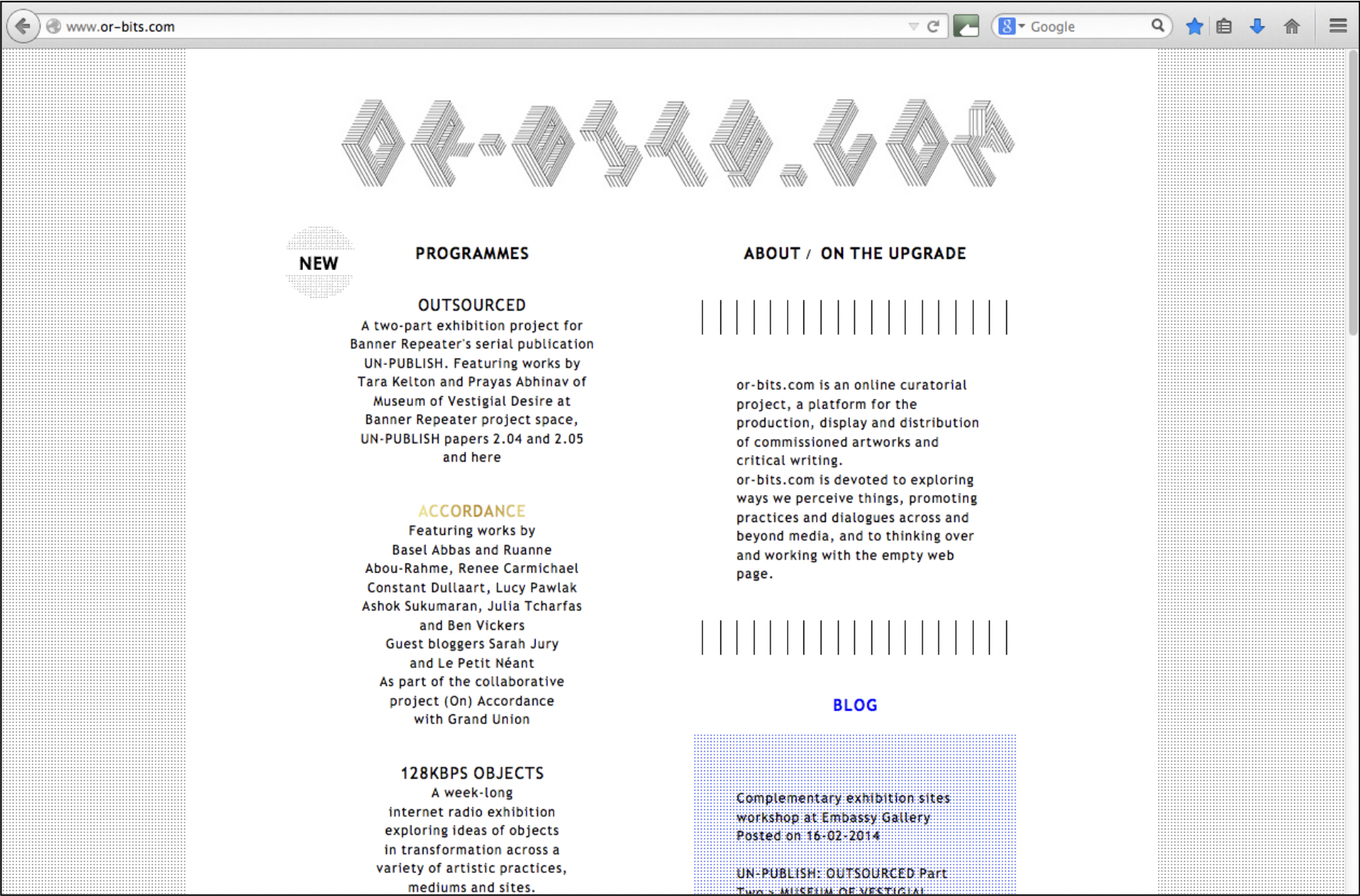 |
url |
| https://sure.sunderland.ac.uk/id/eprint/6088/ |
Titolo |
| Curare con Internet |
Autore |
| Sean Lowry |
Anno |
| 2018 |
CASA EDITRICE |
| Wiley Blackwell |
Descrizione |
| Questo capitolo esplora gli approcci basati su Internet e attivati da Internet per curare l'arte attraverso circuiti espositivi sia consolidati che non tradizionali. Oggigiorno, nuovi approcci curatoriali stanno emergendo in tandem con modalità di presentazione e disseminazione attivate digitalmente e caratterizzate da una perpetua riproducibilità, da molteplici intersecazioni temporali e materializzazioni, e dalla riduzione dello spazio fisico. Di conseguenza, questo capitolo discute approcci in rete, distribuiti e modulari che variamente interrompono, democratizzano, antagonizzano, istituzionalizzano - e in alcuni casi bypassano del tutto - la figura del curatore. Significativamente, molti di questi approcci non sono più necessariamente connessi a eventi o spazi singoli e sono forse meglio intesi come movimenti omnidirezionali tra modi di concezione, produzione e diffusione connessi attraverso lo schermo come spazio comune. Questo spazio comune potrebbe offrire l'accesso a nuove opere, illuminare l'esistenza di opere intese come se fossero altrove nel tempo e nello spazio, o offrire materializzazioni multiple o alternative, versioni, attribuzioni, interpretazioni e rappresentazioni di opere esistenti. Pubblicato in: Un Compagno per la Curatela di Buckley, B. e Conomos, J. |
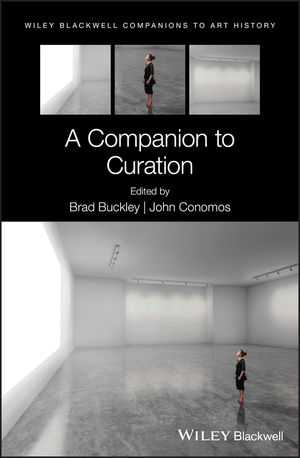 |
url |
| https://www.academia.edu/42023711/Curating_with_the_Internet |
Titolo |
| La curatela e la sua automazione statistica per mezzo dell”Intelligenza’ Artificiale |
Autore |
| Francis Hunger |
Anno |
| 2021 |
CASA EDITRICE |
| Training the Archive (Ed.), Aachen/Dortmund |
Descrizione |
| Il concetto di curatela post-AI discusso in questo Working Paper esplora la curatela come un processo di creazione di conoscenza, supportato da Pattern Recognition e reti ponderate come strumenti tecnici di 'intelligenza' artificiale. Il testo discute una serie di concetti che si costruiscono uno sull' altro, come la curatela, il curatore, il curatoriale, la ricerca sperimentale curatoriale, la curatela post-umana e la curatela post-AI. Successivamente esamina diversi progetti come casi di studio che si avvicinano alla curatela usando l''intelligenza' artificiale: The Next Biennial Should Be Curated by a Machine di UBERMORGEN, Leonardo Impett e Joasia Krysa (2021) come meta-opera sulla curatela e le biennali; il progetto Artificial Curator di Tillmann Ohm (2020), che ha prodotto una mostra curata automaticamente; e #Exstrange di Rebekah Modrak e Marialaura Ghidini et. al. (2017), che presenta opere d'arte come fossero dati oggetti sulla piattaforma online di eBay. Infine il testo passa a riassumere il concetto di incorporazione, infrastrutture di big data, la spazialità e il modello informativo, il soluzionismo e le Digital Humanities, la selezione e la somiglianza come istanze di curatela post-AI. |
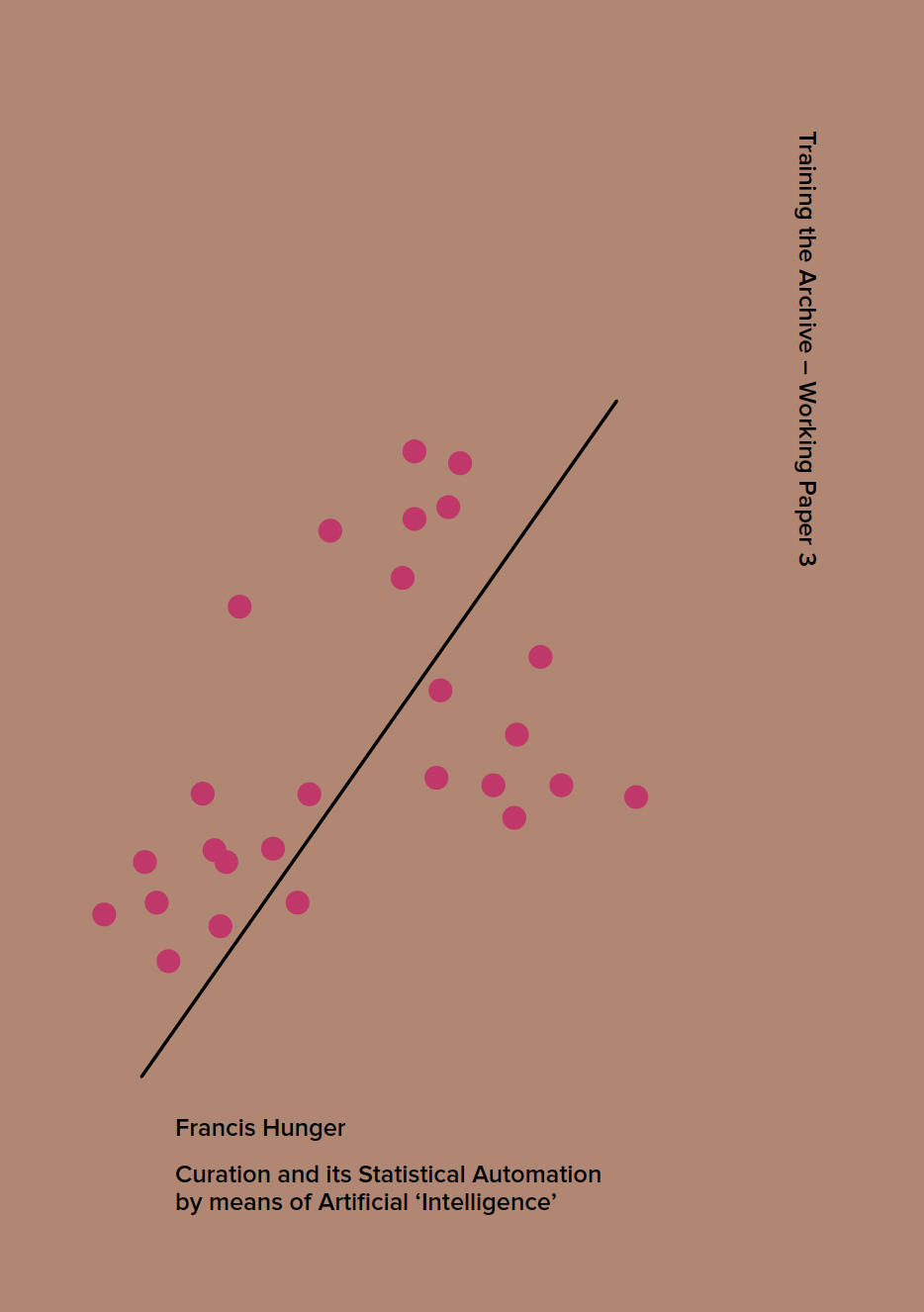 |
url |
| https://trainingthearchive.ludwigforum.de/en/working-paper-3-en/ |
Titolo |
| DATA browser 03 – Curare l’immaterialità: Il lavoro del curatore nell’era dei sistemi di rete |
Autore |
| Joasia Krysa |
Anno |
| 2006 |
CASA EDITRICE |
| Autonomedia |
Descrizione |
| Il campo della produzione curatoriale è stato ingrandito per includere lo spazio di Internet e il fulcro dell'attenzione curatoriale è stato spostato dall'oggetto ai processi ai sistemi dinamici di rete. Di conseguenza, il lavoro curatoriale è diventato più ampiamente distribuito tra molteplici soggetti, comprese le reti tecnologiche e il software. Questo "sistema operativo" dell'arte aggiornato presenta nuove possibilità di curatela online che è collettiva e distribuita - fino ad arrivare agli estremi di un sistema auto-organizzato che si cura da solo. Il curatore è parte di questo intero sistema ma non è al centro di esso. Il sottotitolo del libro fa riferimento al saggio "The Work of Culture in the Age of Cybernetic Systems" (1988), in cui Bill Nichols considerava il modo in cui la cibernetica trasformava la produzione culturale. Nichols ha evidenziato il passaggio dalla riproduzione meccanica (simboleggiata dalla macchina fotografica) a quella dei sistemi cibernetici (simboleggiati dal computer) in relazione all'economia politica, e ha messo in rilievo le tendenze contraddittorie inerenti a questi sistemi: "la tendenza negativa, attualmente dominante, verso il controllo, e il potenziale positivo, più latente, verso la collettività". Il libro continua questa linea generale di indagine in relazione alla curatela, e la estende considerando come i rapporti di potere e il controllo sono espressi nel contesto dei sistemi di rete e dell'immaterialità. In riferimento ai sistemi di rete, l'enfasi rimane sul potenziale democratico del cambiamento tecnologico, ma anche sull'emergere di ciò che appare come forme più intense di controllo. Si può dire lo stesso della curatela nel contesto delle forme distribuite? Se sì, cosa implica questo per la curatela del software al di là della retorica del software libero e dei sistemi aperti? |
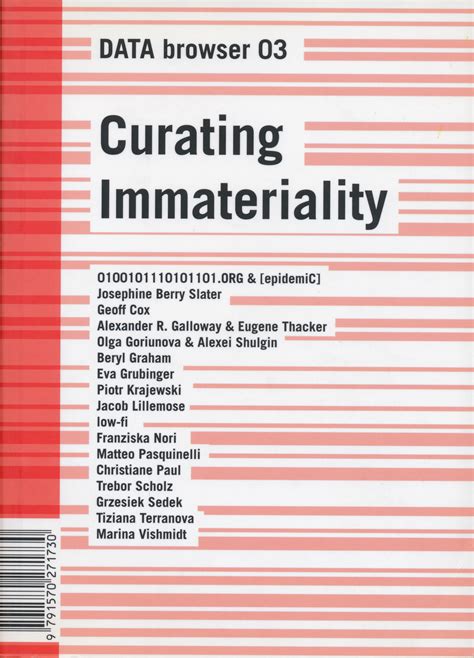 |
url |
| http://data-browser.net/db03.html |
Titolo |
| Abbiamo bisogno di edifici per l’arte digitale? |
Autore |
| Rob Allen |
Anno |
| 2013 |
CASA EDITRICE |
| The Guardian |
Descrizione |
| Con la crescita della curatela online, la pratica digitale sta diventando meno dipendente dai mattoni e calce di uno spazio espositivo? |
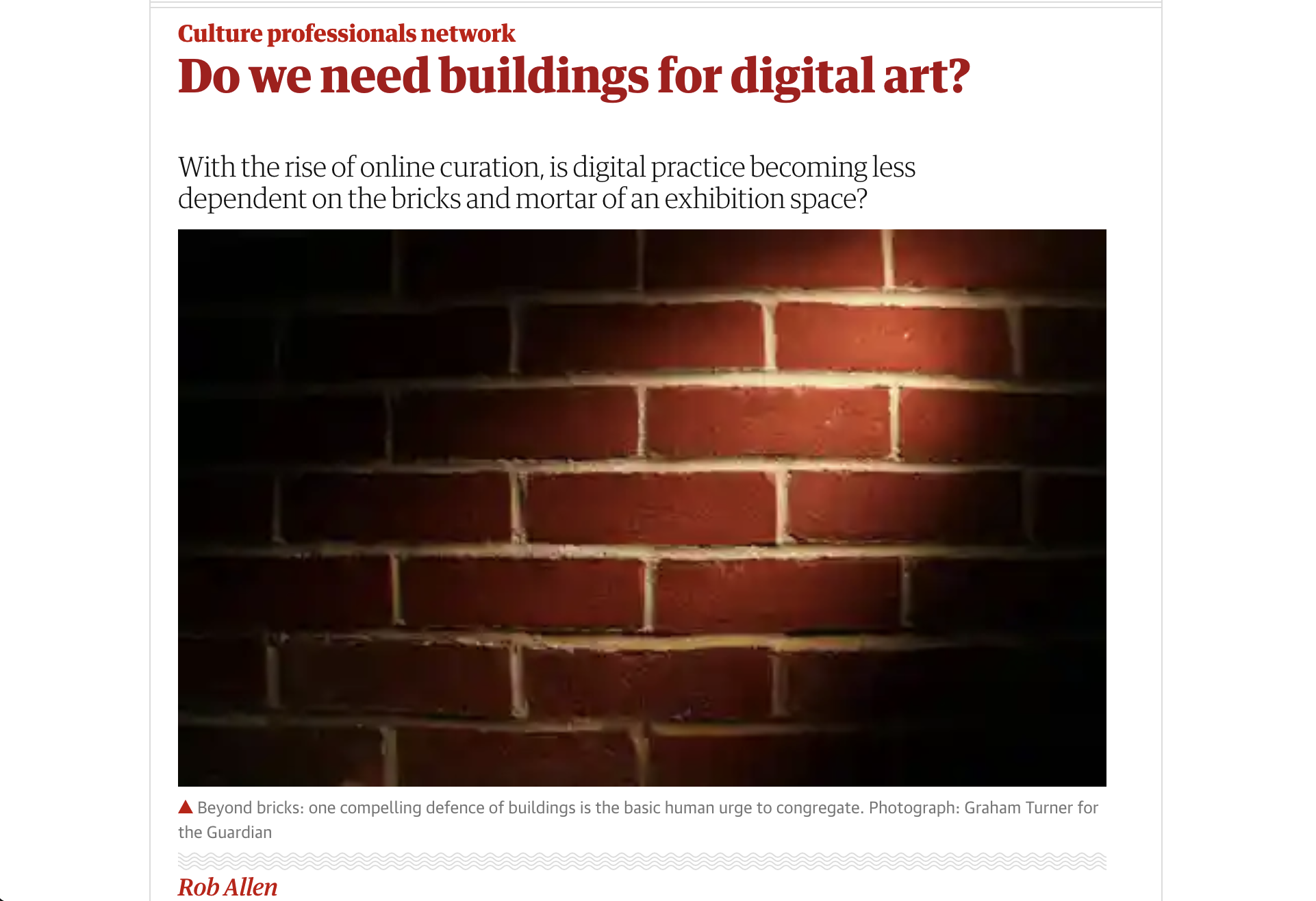 |
url |
| https://www.theguardian.com/culture-professionals-network/culture-professionals-blog/2013/jul/19/does-digital-art-need-buildings#start-of-comments |
Titolo |
| Esperimenti nella curatela (sociale) di software: riprogrammazione della practica curatoriale per la rete |
Autore |
| Joasia Krysa |
Anno |
| 2008 |
CASA EDITRICE |
| Vague Terrain |
Descrizione |
| Il saggio (in Inglese) affronta la questione dei nuovi sviluppi nel campo della curatela nel contesto delle tecnologie dell'informazione. Esplora l'emergere di un approccio interdisciplinare che collega il campo della curatela direttamente con la programmazione di computer e un interesse relativamente recente per la software art. Sebbene ci sia molto lavoro critico e pratiche contemporanee che vengono descritte come programmazione orientata all'arte o software art, il saggio risponde a un divario percepito nelle discussioni sulla curatela di software. È importante sottolineare che in questo contesto il curatela di software non deve essere intesa come l'attività di curare opere di software art (in altre parole l'attività di portare le opere di software art nel dominio pubblico) ma come l'integrazione del software e della programmazione nel processo curatoriale di per sé. Inoltre, il saggio riflette sul recente aumento della popolarità delle tecnologie sociali e sulla loro rilevanza per la curatela. Il suggerimento di fondo è che la curatela risponde a questo contesto sviluppando nuove forme che coinvolgono sempre più le reti socio-tecnologiche e che possono essere caratterizzate da vocazione cosiale e distribuite sulla rete. |
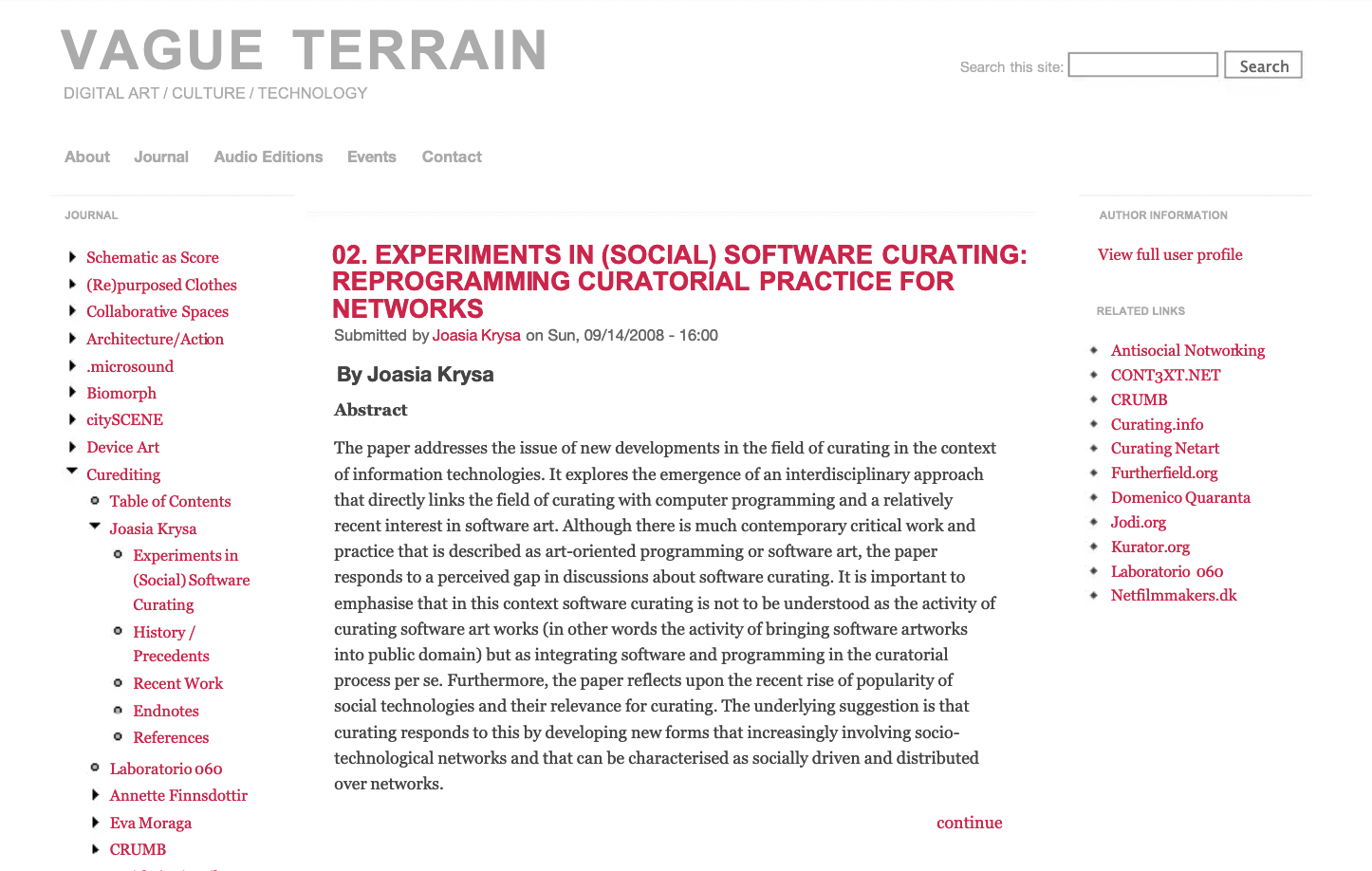 |
Titolo |
| Arte su Internet [net art] |
Autore |
| Sarah Cook, Marialaura Ghidini |
Anno |
| 2015 |
CASA EDITRICE |
| Grove Art Online, Oxford University Press, Regno Unito |
Descrizione |
| Voce di dizionario sull'arte che usa Internet non solo come strumento di produzione e distribuzione ma anche come materiale di partenza o supporto, e sfrutta o riflette le caratteristiche connettive intrinseche di Internet |
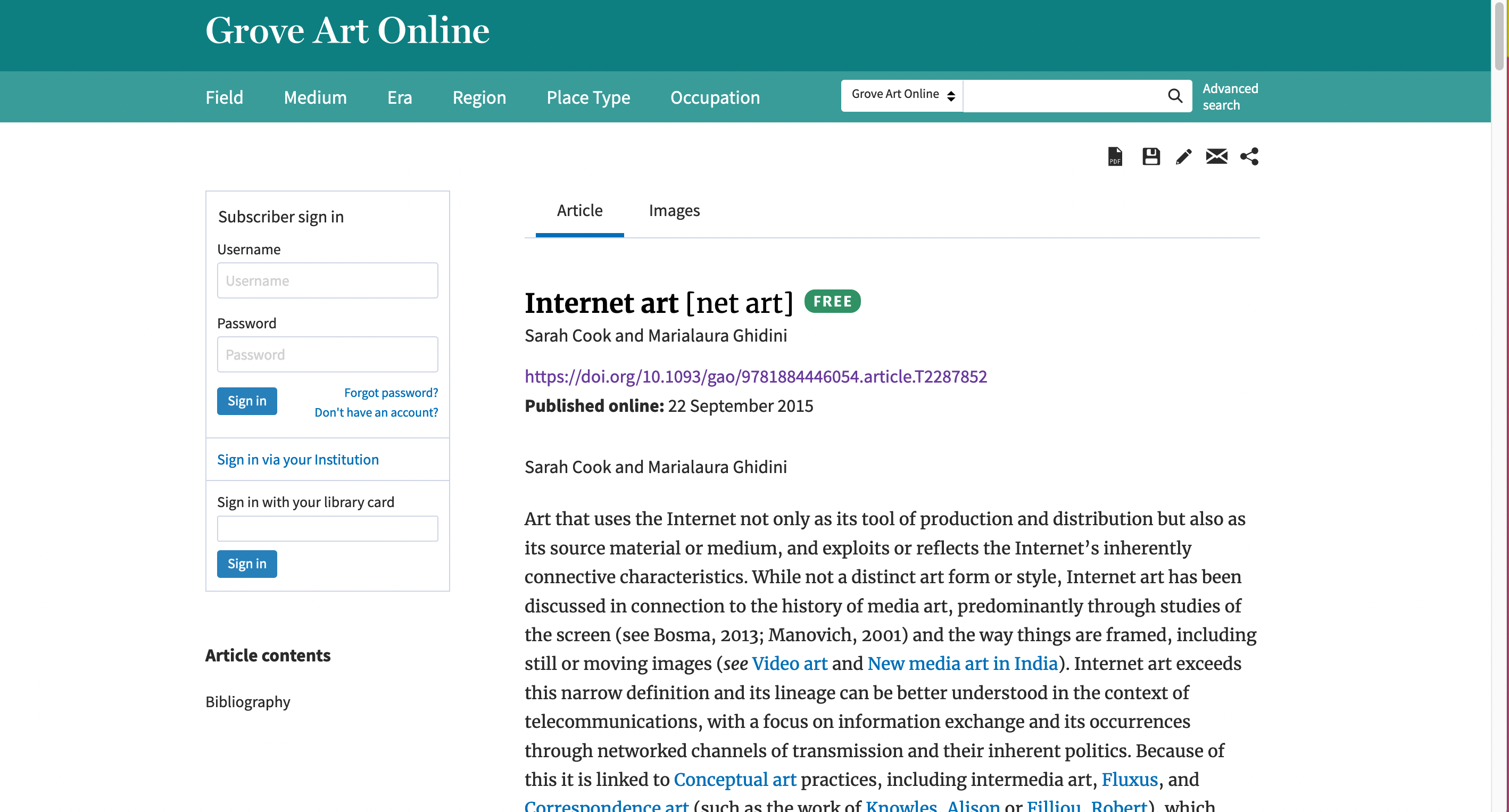 |
url |
| https://doi.org/10.1093/gao/9781884446054.article.T2287852 |